Unit 1 Cultural Heritage Listening and Speaking & Listening and Talking 课件(共26张PPT,内镶嵌视频及音频) 2023-2
文档属性
| 名称 | Unit 1 Cultural Heritage Listening and Speaking & Listening and Talking 课件(共26张PPT,内镶嵌视频及音频) 2023-2 |
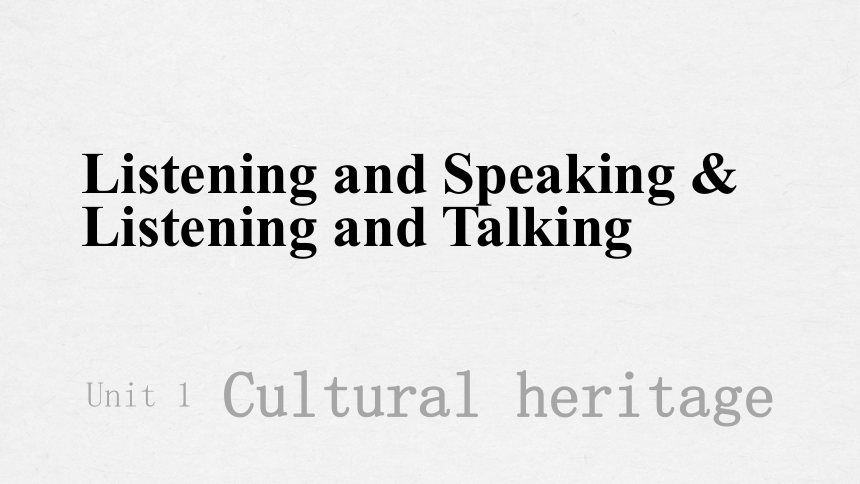
|
|
| 格式 | pptx | ||
| 文件大小 | 38.3MB | ||
| 资源类型 | 教案 | ||
| 版本资源 | 人教版(2019) | ||
| 科目 | 英语 | ||
| 更新时间 | 2024-04-05 16:20:54 | ||
图片预览

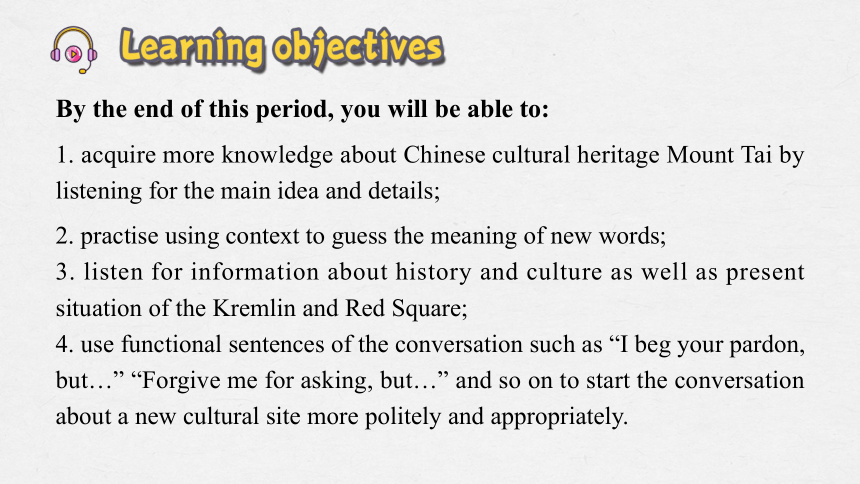
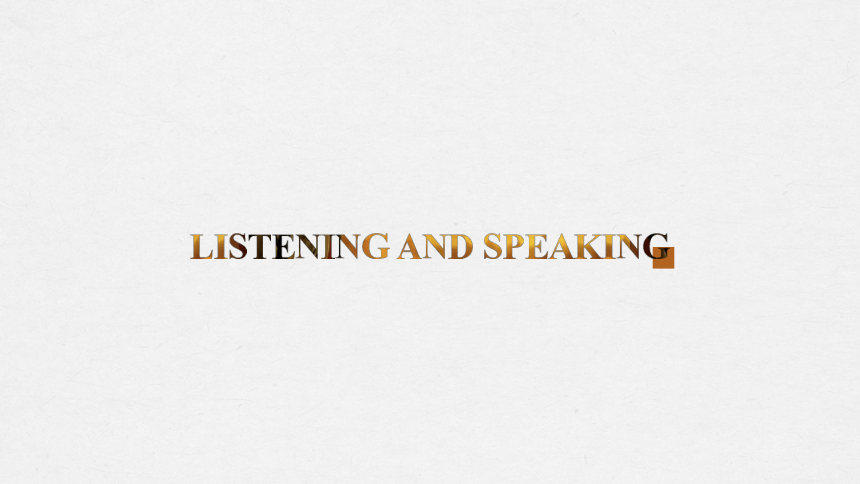
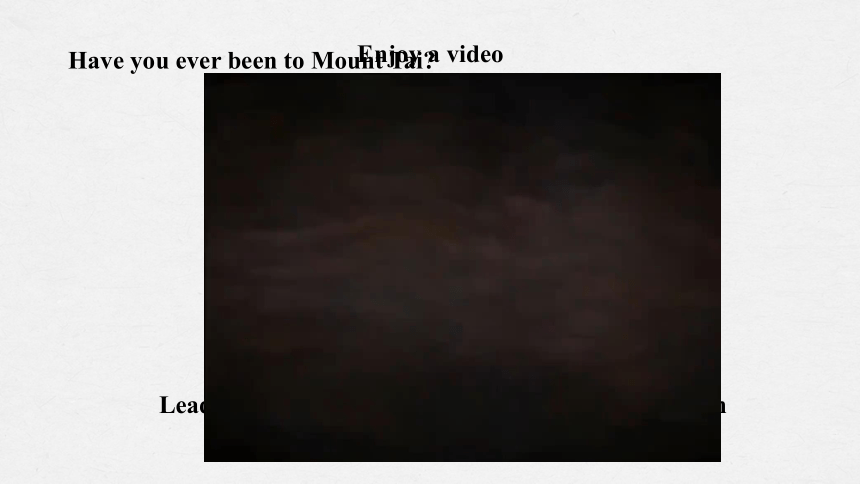
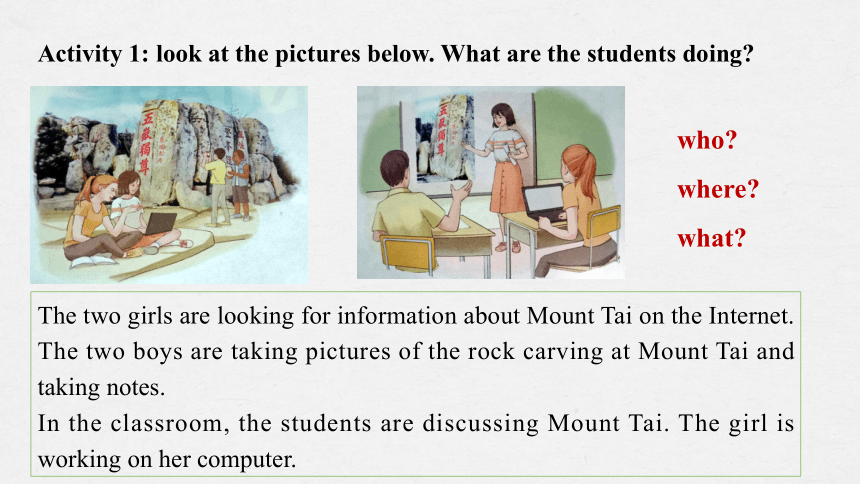
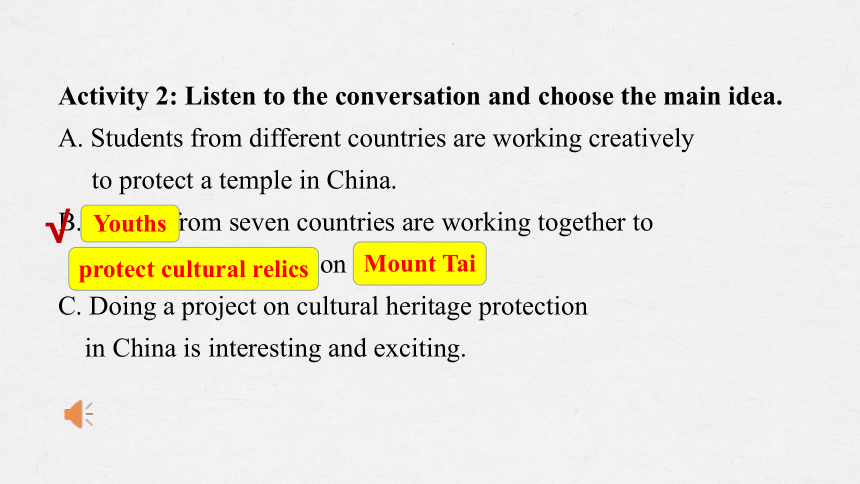
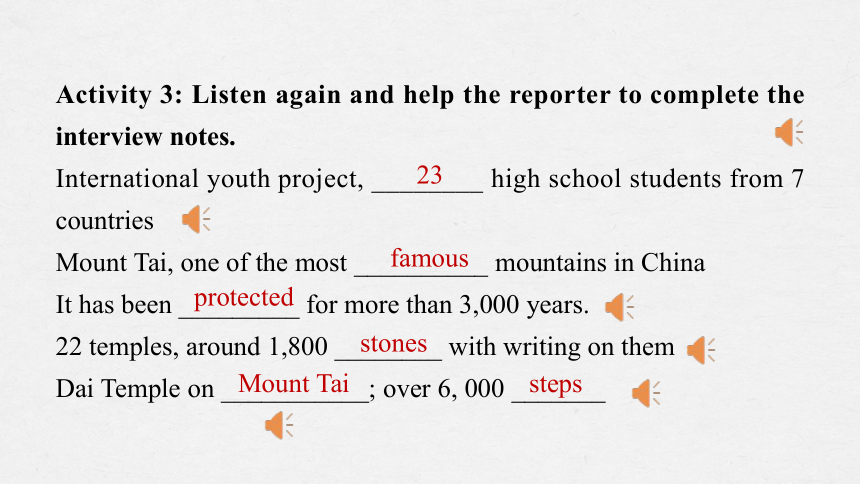
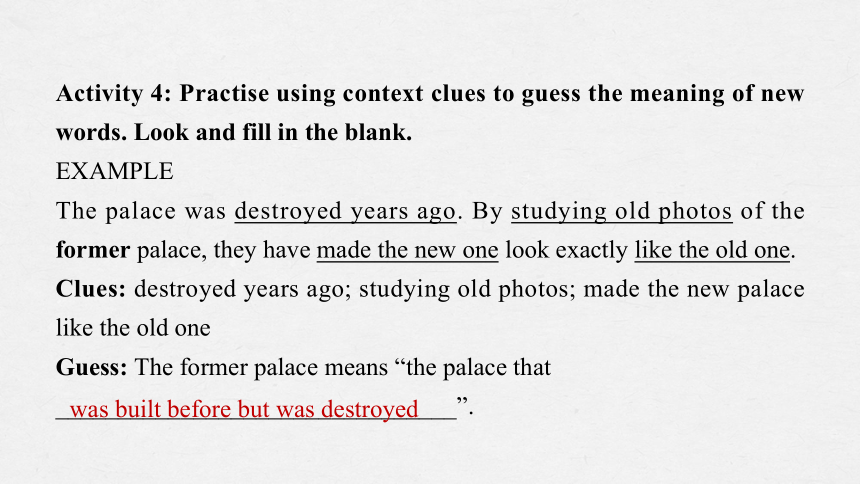
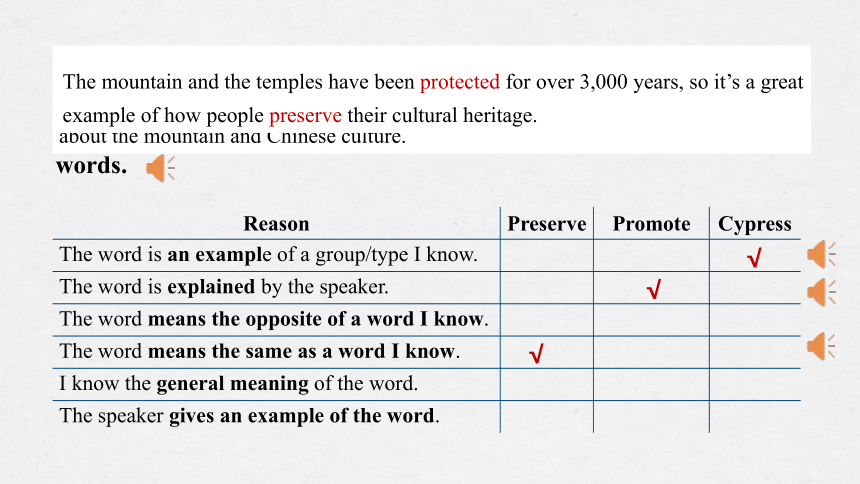
文档简介
(共26张PPT)
Cultural heritage
Unit 1
Listening and Speaking & Listening and Talking
By the end of this period, you will be able to:
1. acquire more knowledge about Chinese cultural heritage Mount Tai by listening for the main idea and details;
2. practise using context to guess the meaning of new words;
3. listen for information about history and culture as well as present situation of the Kremlin and Red Square;
4. use functional sentences of the conversation such as “I beg your pardon, but…” “Forgive me for asking, but…” and so on to start the conversation about a new cultural site more politely and appropriately.
LISTENING AND SPEAKING
Have you ever been to Mount Tai
Leading Peaceful Mountain/Eastern Great Mountain
Enjoy a video
what
where
who
The two girls are looking for information about Mount Tai on the Internet. The two boys are taking pictures of the rock carving at Mount Tai and taking notes.
In the classroom, the students are discussing Mount Tai. The girl is working on her computer.
Activity 1: look at the pictures below. What are the students doing
Activity 2: Listen to the conversation and choose the main idea.
A. Students from different countries are working creatively
to protect a temple in China.
B. Youths from seven countries are working together to
protect cultural relics on Mount Tai.
C. Doing a project on cultural heritage protection
in China is interesting and exciting.
√
Youths
Mount Tai
protect cultural relics
Activity 3: Listen again and help the reporter to complete the interview notes.
International youth project, ________ high school students from 7 countries
Mount Tai, one of the most __________ mountains in China
It has been _________ for more than 3,000 years.
22 temples, around 1,800 ________ with writing on them
Dai Temple on ___________; over 6, 000 _______
23
famous
protected
stones
Mount Tai
steps
Activity 4: Practise using context clues to guess the meaning of new words. Look and fill in the blank.
EXAMPLE
The palace was destroyed years ago. By studying old photos of the former palace, they have made the new one look exactly like the old one.
Clues: destroyed years ago; studying old photos; made the new palace like the old one
Guess: The former palace means “the palace that ________________________________”.
was built before but was destroyed
Activity 5: Listen again and use the context to guess the meaning of the words below. Tick the reason why you were able to guess the words.
Reason Preserve Promote Cypress
The word is an example of a group/type I know.
The word is explained by the speaker.
The word means the opposite of a word I know.
The word means the same as a word I know.
I know the general meaning of the word.
The speaker gives an example of the word.
√
√
√
For example, this game is about the six cypresses that were planted on Mount Tai during the Han Dynasty. You learn about the trees and also the life in China over
2, 000 years ago.
We want to promote Mount Tai; that is, we want to tell teenagers in other countries about the mountain and Chinese culture.
The mountain and the temples have been protected for over 3,000 years, so it’s a great example of how people preserve their cultural heritage.
International Youth Camp Members Create Mount Tai App
Tai’an, 18 June 2019. A group of high school students who are taking part in an international youth camp at Mount Tai are creating a(n) ______ about China’s most famous mountain. The purpose of the camp is to _____________ Mount Tai by introducing it to young people in a fun and easy way. The students are making an app about Mount Tai and taking photos of the __________ and stones. The volunteers also visit middle schools in the area in order to talk to local teenagers. Liu Bin, a member of the camp, says that he is ________ to help Mount Tai as people have done for more than 3,000 years.
app
promote
temples
proud
Activity 6: Help the reporter to complete the news report based on what you hear and the interview notes.
Listening text
Reporter: Hello. What are you guys doing
Stephanie: We’re creating an app about Mount Tai. We’re part of an international youth project.
Reporter: That’s interesting. How many students are taking part in the project
Stephanie: There are 23 senior high school students from seven countries.
Reporter: Why is the project here at Mount Tai
Liu Bin: Well, as you know, Mount Tai is one of the most famous mountains in China. The mountain and the temples have been protected for over 3,000 years, so it’s a great example of how people preserve their cultural heritage. We feel so proud to have a chance to do something.
Reporter: Tell me about the app you’re making.
Liu Bin: We want to promote Mount Tai; that is, we want to tell teenagers in other countries about the mountain and Chinese culture. The app teaches teenagers about Mount Tai and even has a few games about cultural relics.
Reporter: Oh, that’s a clever idea.
Stephanie: Yes. For example, this game is about the six cypresses that were
planted on Mount Tai during the Han Dynasty. You learn about the trees and
also the life in China over 2, 000 years ago.
Reporter: That sounds great! So what else will you put in the app
Liu Bin: Well, there are 22 temples and some 1,800 stones with writing on them. We’ll take photos of them all, and then visit the Dai Temple on Mount Tai, since it has so many important paintings and relics. Another group is reading about Mount Tai and writing texts for the app. We’ll also visit local schools and talk to Chinese students.
Reporter: Do you think that some people will use the app instead of visiting Mount Tai
Liu Bin: No, not a chance! The app is great, but the best way to see Mount Tai is to climb all 6,000 steps!
Reporter: What ! How many steps
Liu Bin & Stephanie: More than 6,000!
Discuss the questions.
1. Would you like to take part in a project like this Why or why not
2. Could you think of more ways to protect the cultural heritage Write them down.
LISTENING AND TALKING
Are you familiar with the buildings in the pictures What do you know about the Kremlin and Red Square
the Kremlin
Moscow, Russia
Red Square
Moscow, Russia
克里姆林(宫)
红场
The Kremlin is a special government area with 5 palaces and 4 cathedrals(教堂). It’s where the president lives.
Saint Basil’s Cathedral (圣瓦希里大教堂) is the symbol of Russia with colorful round towers.
Red Square is considered the centre of Moscow, and many important parades(游行) and events are held there. It used to be a marketplace(集市) a long time ago.
Activity 1: Listen to the conversation and choose the correct answers.
1. Where are the speakers
A. On a street B. On a plane C. On a bus.
2. What are they doing
A. Drawing a map. B. Sightseeing. C. Studying culture.
3. What is the probable relationship between the speakers
A. Tourists and a tour guide. B. Classmates. C. Colleagues.
√
√
√
World Cultural Heritage Site Fact Sheet
THE KREMLIN AND RED SQUARE, MOSCOW
Built between the ______ and ______ centuries
The palace where ___________________ lives
The Saint Basil’s Cathedral looks like _______.
The ______ part of Moscow
Place for parades, concerts and even ________________.
n.&vi. 游行;检阅
14th
17th
the Russian president
a flame
central
ice hockey games
Activity 2: Listen again and complete the fact sheet.
Tour guide: OK, here we are: the Kremlin and Red Square!
Tourist: Excuse me, but what is the Kremlin exactly
Tour guide: The Kremlin is a special government area. Inside, there are five palaces and four cathedrals. It’s where the President lives, too.
Tourist 1:Wow... a little bit like the Palace Museum in Beijing.
Tour guide:Yes. I guess you could say that. The Kremlin was actually built around the same time between the 14th and 17th centuries.
Tourist 1:What’s that building over there, with the colourful round towers I’ve seen so many photos of it. It looks so pretty, like a flame!
Tour guide: That’s Saint Basil’s Cathedral. People all over the world think of Russia when they see it. It’s like the Eiffel Tower in France or the Great Wall in China, a symbol of the country.
Listening text
Tourist 2: Forgive me for asking, but can you tell me more about Red Square
Tour guide: Well, it’s considered the centre of Moscow, and there have been many important parades and events held here. It also used to be a marketplace a long time ago.
Tourist 2: Oh, really How amazing!
Tour guide: I see that you’re looking at the photos of an ice hockey game. Did you know that children can skate on Red Square in the winter
Tourist 2: No way! That’s so cool!
Tour guide: Yes. Red Square is also a place for music concerts. People have a lot of fun here.
Activity 3: Work in groups. Choose a cultural site that you like and role-play a conversation between some tourists and their tour guide. Take turns to play the different roles.
Starting a conversation
I beg your pardon, but…
Forgive me for asking, but…
Excuse me, but what is…
Excuse me. Could you please tell me about…
Do/Did you know…
I see that you are …
EXAMPLE
Tourist A: I beg your pardon, but is this the Xuanyuan Mirror Could you please tell me about it
Tour guide: Yes, it is. It is said that it’s a mirror that can tell right from wrong! ... I see that you’re looking at that carving on the roof. Did you know that it’s called chiwen — one of the nine sons of the Chinese dragon
Tourist B: No, I didn’t. That’s so interesting!
n.镜子
n. 屋顶;顶部
Sample dialogue 1
Tourist: Forgive me for asking, but what was the Forbidden City used for in history
Tour Guide: Well, it is said that the Forbidden City served as the home of emperors and their households as well as the ceremonial and political centre of Chinese government for almost 500 years.
Tourist: I see that you’re looking at that valuable vase. Do you know anything about it
Tour Guide: It’s called “blue porcelain”. Some 1.17 million pieces of art are thought to be stored in the Forbidden City, so it is also called “the Palace Museum”.
Tourist: That’s really amazing!
…
Sample dialogue 2
Tourist: Forgive me for asking, but what was the Terra-cotta Army used for
Tour guide: Well, it is said that the Terra-cotta Army was made to guard Qinshihuang’s tomb. I see that you are looking at the different faces of the statues. Do you know why
Tourist: I have no idea.
Tour guide: Researchers think that each statue is a copy of a real soldier.
Tourist: It’s so amazing! Excuse me, but when was it found
Tour guide: It was found in 1974, when some farmers were digging a well.
Cultural heritage
Unit 1
Listening and Speaking & Listening and Talking
By the end of this period, you will be able to:
1. acquire more knowledge about Chinese cultural heritage Mount Tai by listening for the main idea and details;
2. practise using context to guess the meaning of new words;
3. listen for information about history and culture as well as present situation of the Kremlin and Red Square;
4. use functional sentences of the conversation such as “I beg your pardon, but…” “Forgive me for asking, but…” and so on to start the conversation about a new cultural site more politely and appropriately.
LISTENING AND SPEAKING
Have you ever been to Mount Tai
Leading Peaceful Mountain/Eastern Great Mountain
Enjoy a video
what
where
who
The two girls are looking for information about Mount Tai on the Internet. The two boys are taking pictures of the rock carving at Mount Tai and taking notes.
In the classroom, the students are discussing Mount Tai. The girl is working on her computer.
Activity 1: look at the pictures below. What are the students doing
Activity 2: Listen to the conversation and choose the main idea.
A. Students from different countries are working creatively
to protect a temple in China.
B. Youths from seven countries are working together to
protect cultural relics on Mount Tai.
C. Doing a project on cultural heritage protection
in China is interesting and exciting.
√
Youths
Mount Tai
protect cultural relics
Activity 3: Listen again and help the reporter to complete the interview notes.
International youth project, ________ high school students from 7 countries
Mount Tai, one of the most __________ mountains in China
It has been _________ for more than 3,000 years.
22 temples, around 1,800 ________ with writing on them
Dai Temple on ___________; over 6, 000 _______
23
famous
protected
stones
Mount Tai
steps
Activity 4: Practise using context clues to guess the meaning of new words. Look and fill in the blank.
EXAMPLE
The palace was destroyed years ago. By studying old photos of the former palace, they have made the new one look exactly like the old one.
Clues: destroyed years ago; studying old photos; made the new palace like the old one
Guess: The former palace means “the palace that ________________________________”.
was built before but was destroyed
Activity 5: Listen again and use the context to guess the meaning of the words below. Tick the reason why you were able to guess the words.
Reason Preserve Promote Cypress
The word is an example of a group/type I know.
The word is explained by the speaker.
The word means the opposite of a word I know.
The word means the same as a word I know.
I know the general meaning of the word.
The speaker gives an example of the word.
√
√
√
For example, this game is about the six cypresses that were planted on Mount Tai during the Han Dynasty. You learn about the trees and also the life in China over
2, 000 years ago.
We want to promote Mount Tai; that is, we want to tell teenagers in other countries about the mountain and Chinese culture.
The mountain and the temples have been protected for over 3,000 years, so it’s a great example of how people preserve their cultural heritage.
International Youth Camp Members Create Mount Tai App
Tai’an, 18 June 2019. A group of high school students who are taking part in an international youth camp at Mount Tai are creating a(n) ______ about China’s most famous mountain. The purpose of the camp is to _____________ Mount Tai by introducing it to young people in a fun and easy way. The students are making an app about Mount Tai and taking photos of the __________ and stones. The volunteers also visit middle schools in the area in order to talk to local teenagers. Liu Bin, a member of the camp, says that he is ________ to help Mount Tai as people have done for more than 3,000 years.
app
promote
temples
proud
Activity 6: Help the reporter to complete the news report based on what you hear and the interview notes.
Listening text
Reporter: Hello. What are you guys doing
Stephanie: We’re creating an app about Mount Tai. We’re part of an international youth project.
Reporter: That’s interesting. How many students are taking part in the project
Stephanie: There are 23 senior high school students from seven countries.
Reporter: Why is the project here at Mount Tai
Liu Bin: Well, as you know, Mount Tai is one of the most famous mountains in China. The mountain and the temples have been protected for over 3,000 years, so it’s a great example of how people preserve their cultural heritage. We feel so proud to have a chance to do something.
Reporter: Tell me about the app you’re making.
Liu Bin: We want to promote Mount Tai; that is, we want to tell teenagers in other countries about the mountain and Chinese culture. The app teaches teenagers about Mount Tai and even has a few games about cultural relics.
Reporter: Oh, that’s a clever idea.
Stephanie: Yes. For example, this game is about the six cypresses that were
planted on Mount Tai during the Han Dynasty. You learn about the trees and
also the life in China over 2, 000 years ago.
Reporter: That sounds great! So what else will you put in the app
Liu Bin: Well, there are 22 temples and some 1,800 stones with writing on them. We’ll take photos of them all, and then visit the Dai Temple on Mount Tai, since it has so many important paintings and relics. Another group is reading about Mount Tai and writing texts for the app. We’ll also visit local schools and talk to Chinese students.
Reporter: Do you think that some people will use the app instead of visiting Mount Tai
Liu Bin: No, not a chance! The app is great, but the best way to see Mount Tai is to climb all 6,000 steps!
Reporter: What ! How many steps
Liu Bin & Stephanie: More than 6,000!
Discuss the questions.
1. Would you like to take part in a project like this Why or why not
2. Could you think of more ways to protect the cultural heritage Write them down.
LISTENING AND TALKING
Are you familiar with the buildings in the pictures What do you know about the Kremlin and Red Square
the Kremlin
Moscow, Russia
Red Square
Moscow, Russia
克里姆林(宫)
红场
The Kremlin is a special government area with 5 palaces and 4 cathedrals(教堂). It’s where the president lives.
Saint Basil’s Cathedral (圣瓦希里大教堂) is the symbol of Russia with colorful round towers.
Red Square is considered the centre of Moscow, and many important parades(游行) and events are held there. It used to be a marketplace(集市) a long time ago.
Activity 1: Listen to the conversation and choose the correct answers.
1. Where are the speakers
A. On a street B. On a plane C. On a bus.
2. What are they doing
A. Drawing a map. B. Sightseeing. C. Studying culture.
3. What is the probable relationship between the speakers
A. Tourists and a tour guide. B. Classmates. C. Colleagues.
√
√
√
World Cultural Heritage Site Fact Sheet
THE KREMLIN AND RED SQUARE, MOSCOW
Built between the ______ and ______ centuries
The palace where ___________________ lives
The Saint Basil’s Cathedral looks like _______.
The ______ part of Moscow
Place for parades, concerts and even ________________.
n.&vi. 游行;检阅
14th
17th
the Russian president
a flame
central
ice hockey games
Activity 2: Listen again and complete the fact sheet.
Tour guide: OK, here we are: the Kremlin and Red Square!
Tourist: Excuse me, but what is the Kremlin exactly
Tour guide: The Kremlin is a special government area. Inside, there are five palaces and four cathedrals. It’s where the President lives, too.
Tourist 1:Wow... a little bit like the Palace Museum in Beijing.
Tour guide:Yes. I guess you could say that. The Kremlin was actually built around the same time between the 14th and 17th centuries.
Tourist 1:What’s that building over there, with the colourful round towers I’ve seen so many photos of it. It looks so pretty, like a flame!
Tour guide: That’s Saint Basil’s Cathedral. People all over the world think of Russia when they see it. It’s like the Eiffel Tower in France or the Great Wall in China, a symbol of the country.
Listening text
Tourist 2: Forgive me for asking, but can you tell me more about Red Square
Tour guide: Well, it’s considered the centre of Moscow, and there have been many important parades and events held here. It also used to be a marketplace a long time ago.
Tourist 2: Oh, really How amazing!
Tour guide: I see that you’re looking at the photos of an ice hockey game. Did you know that children can skate on Red Square in the winter
Tourist 2: No way! That’s so cool!
Tour guide: Yes. Red Square is also a place for music concerts. People have a lot of fun here.
Activity 3: Work in groups. Choose a cultural site that you like and role-play a conversation between some tourists and their tour guide. Take turns to play the different roles.
Starting a conversation
I beg your pardon, but…
Forgive me for asking, but…
Excuse me, but what is…
Excuse me. Could you please tell me about…
Do/Did you know…
I see that you are …
EXAMPLE
Tourist A: I beg your pardon, but is this the Xuanyuan Mirror Could you please tell me about it
Tour guide: Yes, it is. It is said that it’s a mirror that can tell right from wrong! ... I see that you’re looking at that carving on the roof. Did you know that it’s called chiwen — one of the nine sons of the Chinese dragon
Tourist B: No, I didn’t. That’s so interesting!
n.镜子
n. 屋顶;顶部
Sample dialogue 1
Tourist: Forgive me for asking, but what was the Forbidden City used for in history
Tour Guide: Well, it is said that the Forbidden City served as the home of emperors and their households as well as the ceremonial and political centre of Chinese government for almost 500 years.
Tourist: I see that you’re looking at that valuable vase. Do you know anything about it
Tour Guide: It’s called “blue porcelain”. Some 1.17 million pieces of art are thought to be stored in the Forbidden City, so it is also called “the Palace Museum”.
Tourist: That’s really amazing!
…
Sample dialogue 2
Tourist: Forgive me for asking, but what was the Terra-cotta Army used for
Tour guide: Well, it is said that the Terra-cotta Army was made to guard Qinshihuang’s tomb. I see that you are looking at the different faces of the statues. Do you know why
Tourist: I have no idea.
Tour guide: Researchers think that each statue is a copy of a real soldier.
Tourist: It’s so amazing! Excuse me, but when was it found
Tour guide: It was found in 1974, when some farmers were digging a well.
